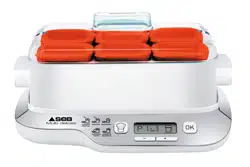Loading ...
Loading ...
Loading ...

123122
EN
Cultures
For yogurts
This is done in one of the following ways:
• Using a natural yogurt from a shop, with as long a use-by date as
possible, since the yogurt will contain more active cultures, which will
give you a firmer yogurt.
• Using a freeze-dried culture. In this case, respect the activation time
indicated in the culture instructions. You can find these cultures in
supermarkets, pharmacies and some health food stores.
• Using a yogurt you have made yourself – this must be natural and
recently made. This is what we call reuse. After 5 reuses, yogurt becomes
depleted in active cultures and the result may be a less firm consistency.
It is therefore important to start with a commercial yogurt or a freeze-
dried culture.
NOTE: If you have heated the milk, wait for it to return to room
temperature before adding the culture.
NOTE: A very high heat could destroy the properties of the culture.
For other cheese products:
fresh cheese and small delicacies
• Culture: you must use a fresh white cheese for cheese making.
• Rennet: for cheese making you must add a few drops of rennet (which
you can find in pharmacies or in specialist organic stores).
Trick: you can substitute rennet with a tablespoon of lemon juice.
• Powdered milk: with powdered milk, you will get very fatty yogurts.
Follow the instructions indicated on the manufacturer's packaging.
When do you need to sweeten?
For yogurts and fresh cheeses:
You can sweeten your yogurts when tasting or before preparing; you can
do this by adding sugar to the milk at the same time as the cultures and
mixing well with a fork or a whisk until it dissolves.
YOGURT PREPARATION
(PROGRAMMES 1 AND 2)
Preparing the mixture
5
• You will need milk, preferably whole, and a culture (see
choice of ingredients).
• If you have chosen a yogurt as a culture: to obtain
a good mixture, you must gently beat the yogurt
with the help of a fork or whisk, with a little milk to
transform it into a very smooth paste. Then add the
rest of the milk while continuing to mix.
• Share the mixture among the jars using the ladle
included with the device (fig.5).
For 6 jars: 750 ml of milk, culture of your choice.
For 12 jars: 1.5 L of milk, culture of your choice.
Number of jars Quantity of milk Culture
6 750 ml
1 jar of yogurt or 1 sachet
of freeze-dried cultures
12 1.5 l
1 jar of yogurt or 1 sachet
of freeze-dried cultures
Observation:
If you do not want to prepare the maximum number
of containers, you must cover the unused holes with
empty containers or with container lids.
Loading ...
Loading ...
Loading ...
